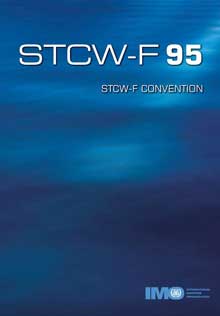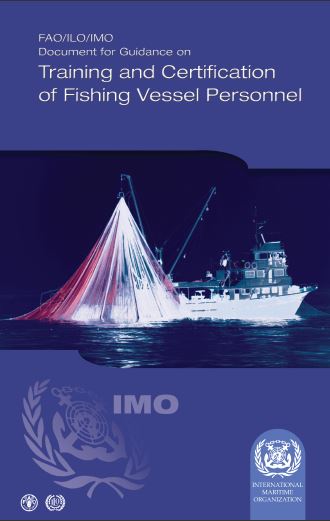International Convention on Standards of Training, Certification and Watchkeeping for Fishing Vessel Personnel (STCW-F), 1995
Adoption: 7 July 1995
Entry into force: 29 September 2012
The International Convention on Standards of Training, Certification and Watchkeeping for Fishing Vessel Personnel (STCW-F), was adopted by IMO in 1995. The 1995 STCW-F Convention is a binding treaty that sets certification and minimum training requirements for crews of seagoing fishing vessels with the aim to promote the safety of life at sea and the protection of the marine environment, taking into account the unique nature of the fishing industry and the fishingworking environment.
This Convention generally applies to personnel of seagoing fishing vessels and, in particular, to skippers and officers in the deck department of fishing vessels of 24 metres in length and over, and officers in the engine department of fishing vessels of powered by main propulsion machinery of 750 kW propulsion power or more.
Why become Party to the IMO STCW-F?
The 1995 STCW-F Convention is a key building block in the promotion of safety of life at sea by setting the necessary framework to ensure the provision of duly skilled personnel in the fisheries sector. Better skilled and trained personnel will decrease the likelihood of fatal accidents and will therefore decrease the loss of lives at sea and improve general safety of fishing operations.
The STCW-F Convention supports harmonization of qualifications by introducing a minimum level of training for everyone working on fishing vessels to which the Convention applies. This, in turn, facilitates free mobility of workers between countries that have ratified and implemented the STCW-F Convention and creates a level playing field in the sector. In most high seas fishing fleets (e.g. pelagic trawlers, tuna long liners and purse seiners) the percentage of migrant workers has increased rapidly over the last decades. Recently, also in small-scale vessel segments the numbers of migrant workers are rising as, in some countries, it is challenging to find sufficient youth interested in a job in the fisheries sector. Language barriers and related communication challenges on board make it even more important that all crew have received proper training and are competent to carry out their work, as dependency on co-workers is high.
In addition, wide ratification and enforcement of the instrument will reduce the cost of search and rescue operations and connected administrative costs.
Scope and application
The STCW-F Convention generally applies to personnel serving on board seagoing fishing vessels entitled to fly the flag of a Party.
The STCW-F Convention not only contains mandatory provisions for certification of skippers, officers, engineer officers and radio operators of fishing vessels, but also contains important provisions on basic safety training, which are applicable to all fishing vessel personnel; and watchkeeping provisions. A Contracting Party may determine that certain provisions (regulations II/3, II/4 and II/5 and the requirement of the use of English language) should not apply, wholly or in part, to personnel of fishing vessels of less than 45 meters in length operating solely from its ports and fishing within its limited waters.
Content
The STCW-F Convention consists of 15 articles, one annex containing technical regulations, three appendices and nine resolutions. The Convention sets certification and minimum training requirements for crews of seagoing fishing vessels, which countries are obliged to meet or exceed. Chapter I of the annex contains “General provisions”, and Chapter II deals with “Certification of skippers, officers, engineer officers and radio operators”. Chapter III outlines the basic safety training requirements for all fishing vessel personnel. In this context, fishing vessel personnel shall, before being assigned to any shipboard duties, receive basic training or instruction and shall meet the appropriate standard of competence in the following areas:
- personal survival techniques, including donning of lifejackets and, as appropriate, immersion suits;
- fire prevention and firefighting;
- emergency procedures;
- elementary first aid;
- prevention of marine pollution; and
- prevention of shipboard accidents.
It is the duty of the Contracting Party to determine whether and, if so, to what extent, the provisions shall apply to personnel of small fishing vessel or personnel already employed on fishing vessels.
Finally, Chapter IV details requirements to be observed on board in relation to keep a navigational watch on board the fishing vessel (watchkeeping).
The STCW-F Convention is being comprehensively reviewed (March 2020) by IMO’s Sub Committee on Human Element, Training and Watchkeeping, in order to align the standards of the Convention with the current state of the fishing industry, and to make available an effective instrument, which will contribute to addressing the significant challenges of this sector.
How to become a Party to the STCW-F?
States may become Parties to the Convention by depositing an instrument to that effect with the IMO Secretary-General.
The 1995 STCW-F Convention is currently being comprehensive reviewed by the Sub-Committee on Human Element, Training and Watchkeeping in order to align the standards of the Convention with the current state of the fishing industry, and to make available an effective instrument, which will contribute to addressing the significant challenges of this sector.
* For the status of ratification of STCW-F Convention including global tonnage figures, please refer to the Status of Treaties Module of GISIS:
visit GISIS website(https://gisis.imo.org) > Status of Treaties > Reports > Status of Treaties > By treaty, and select STCW-F 1995. The status of ratification of STCW 1978 Convention is also available by selecting STCW 1978.
Other related documents:
FAO, ILO and IMO are providing guidelines, conventions and codes in relation to fishing vessel safety. The publications below are jointly produced by FAO, ILO, and IMO and are available on-line at the IMO publishing bookshop.
Document for Guidance on Training and Certification of Fishing Vessel Personnel

The purpose of the Document for Guidance is to provide information with a view to improve the training, certification and watchkeeping standards of fishing vessel personnel. The Document for Guidance took account of the conventions and recommendations adopted by ILO and IMO and the wide practical experience of FAO in the field of fishermen’s training and covered training and certification of small-scale and industrial fishermen.
In 1995 a joint working group, in co-operation with FAO and ILO, reviewed the Document for Guidance with particular reference to relevant resolutions of the STCW-F Convention. The outcome was a revised document entitled Document for Guidance on Training and Certification of Fishing Vessel Personnel, which was approved by FAO, ILO and IMO in 2000 and published on behalf of the three organizations by IMO in 2001.
Code of safety for fishermen and fishing vessels
The Code of Safety for Fishermen and Fishing Vessels was approved by FAO, ILO and IMO. The Code is divided into two parts: Part A for skippers and crews, and Part B for fishing vessel builders and owners.
The Code was adopted by the first session of the Joint FAO/ILO/IMO Meeting of Consultants on Safety on Board Fishing Vessels which was held at ILO Headquarters in Geneva in September 1968, provides guidance on the development of national codes and fishermen's education and training manuals and guidance on the safety and health of fishermen. Competent authorities are encouraged to make use of the contents of the Code and the Voluntary Guidelines in the production of safety and health and training materials in an appropriate format to suit the particular needs of the fisheries of the country or region and in local languages.
Amendments to Part A and Part B of the Code were approved by the IMO Maritime Safety Committee (MSC) at its thirtieth session in 1973 which was endorsed by the FAO Council at its 64th session in 1974 and also endorsed by the Governing Body of the ILO at its 195th session in 1975.
The revised Code was approved by the Maritime Safety Committee (MSC) in 2004, by the FAO Committee of Fisheries in 2005, and by ILO in 2005.
The Code of safety for fishermen and fishing vessels (Part A)
The purpose of part A of the Code is to provide information with a view to promoting the safety and health of crew members on board fishing vessel.
The Code of safety for fishermen and fishing vessels (Part B)
The purpose of part B of the Code is to provide information on the design, construction, and equipment of fishing vessels with a view to promoting the safety of fishing vessels.
Voluntary Guidelines for the design, construction and equipment of small fishing vessels
The purpose of the Voluntary Guidelines is to provide information on the design, construction, and equipment of small fishing vessels.
The Guidelines was revised and approved by the IMO,FAO and ILO in 2005.